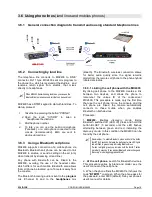
Channel 6 /USB/IP
gives the audio from the device
connected to that input, a jack TRS with switch.
When the TRS input is not connected, the knob
gives the sum of the USB signal and the return of
streaming IP (not implemented yet).
Channels MIC/LIN-3; MIC/LIN-4 y MIC/LIN-5
supports microphone signals (XLR) or line signals
(Jack 1/4”). See Section 2.
Stereo mix
The signal in the stereo program output is
generated from the fixed panning of mic channels
and the stereo input “Line 6”. We recommend to
use microphones cardioid-type.
Stereo panning of each channel, indicated at the
front panel, is the following:
Left
Right
MIC 1
MIC 2
MIC 3
MIC 4
MIC 5
LIN 6
(stereo)
Table 4.1
Examples:
In live music show,
m
icrophones 1 to 4
are used to take all music, being panned to the left
and right. The microphone 5 must be used for the
singer or a centred instrument, as the bass drum of a
battery, which plays for both channels.
In the case of a
sports transmission
, you can use
Mic 1 and Mic 2 for the environment, locating them
with a minimum separation of 2 meters. The
rapporteur will use the main MIC-5 (center).
2.2.4
Headphone Mixer
Mix for headphones is made with four knobs:
2.2.4.1 STUDIO
Gives the return from Studios when using a
telephone line connected to RJ11 (land or wired cell
phone) or the on-the-air transmission when an
external tuner is connected to the TUNER input.
When you connect the TUNER input, the signal at
this input is sent to the headphones mix through the
knob 'STUDIO'. When this input is not used, the
knob 'STUDIO' manages the return signal from
RJ11, which can be connected to a landline or a cell
phone with an adapter cable.
When you open STUDIO, being the RJ11
unconnected , the output signal of the console
appears on the channel Studio, due to the Hybrid's
circuit is unbalanced. Therefore, in these cases
STUDIO knob must always stay closed. This
situation resolves:
•
Connecting the jack TUNER. This action
disconnects the hybrid monitoring.
•
Connecting a land line to RJ11. Hybrid is
balanced and STUDIO gives you the return
from Studios and very attenuated residual
local signal.
•
Connecting to a cell phone to RJ11, using
the cable adaptor. It cancels completely the
Studio return since hybrids turn to of 4
threads.
2.2.4.2 CONSOLE
Manage the program signal generated by the
console. It can be stereo or mono.
2.2.4.3 BLUETH
Gives the return from the cell phone linked to the
console via Bluetooth.
2.2.4.4 TCP/IP
Lets you listen a pre-recorded voice that reports the
IP number
assigned to the console when it
connects to an Internet network.
This is useful in the absence of a hosting server or
for technical testing.
2.2.5
MONO/STEREO
Switch the listening mode of the headphone mixer.
In the MONO position (pressed), you listen the
mono mix, the sum of all inputs.
In STEREO (released), you listen microphone
inputs according to the fixed panning (see Table
4.1).
WARNING :
Mono/Stereo
button also switches the signal as
MONO for the digital stage (streaming). When
the MX2400 is set (via http) to transmit mono
streaming, the button
Mono/Stereo
must be
pressed (mono) to enable the use of all the
microphones. In this mode, the Talk-Back
microphone adds to the streaming mix, so Talk-
back can not be used for a private
communication with studios while the console
is on the air (with mono streaming).
SOLIDYNE
CODEC–MIXER MX2400
Page 12













































